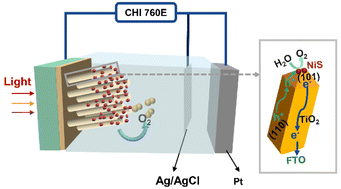Enhanced photoelectrochemical performance of NiS-modified TiO2 nanorods with a surface charge accumulation facet†
Abstract
Photoelectrochemical (PEC) water splitting for hydrogen production technology is considered as one of the most promising solutions to energy shortage and environmental remediation. TiO2/NiS nanorod arrays were successfully prepared using hydrothermal deposition followed by the successive ionic layer adsorption and reaction (SILAR) method. X-ray diffraction (XRD), X-ray photoelectron spectroscopy (XPS), scanning electron microscopy (SEM) and photoluminescence (PL) spectra characterization studies indicate the successful deposition of NiS on TiO2 NRs. The NiS deposition on TiO2 was optimized by controlling the impregnation cycle. The optimal sample exhibits a photocurrent density of 1.16 mA cm−2 at 0.6 V vs. Ag/AgCl, which is a 1.9-fold enhancement over that of pristine TiO2 nanorod arrays. The enhanced photoelectrochemical performance can be attributed to two aspects. On the one hand, the (101) crystal plane of rutile TiO2 is the facet where photogenerated holes accumulate and is an efficient active plane for the oxygen evolution reaction; on the other hand, NiS is a narrow band gap semiconductor, and its deposition on TiO2 nanorods can further promote the separation and transport of photogenerated charge carriers.



 Please wait while we load your content...
Please wait while we load your content...